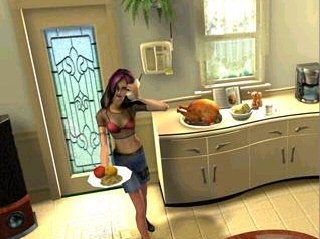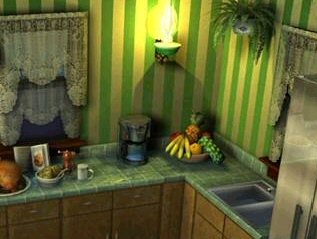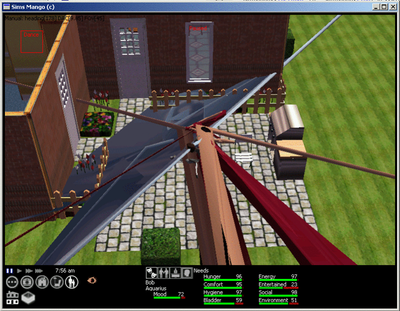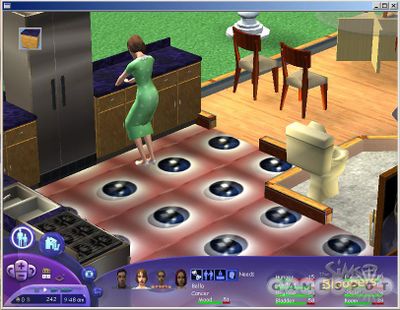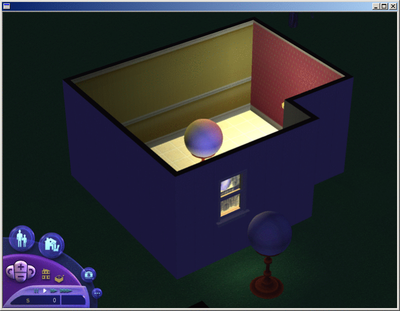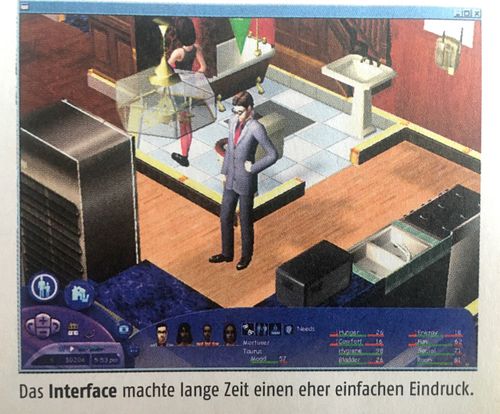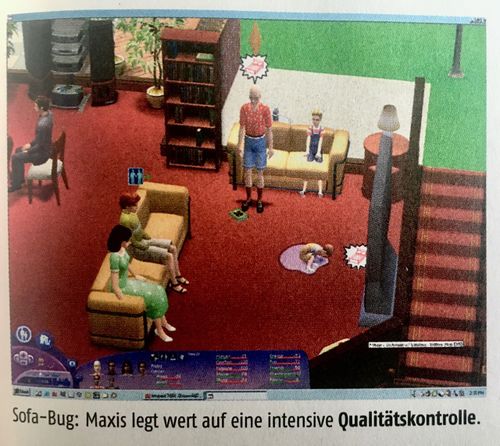Prerelease:The Sims 2 (Windows)/Early Development
This is a sub-page of Prerelease:The Sims 2 (Windows).
| To do: Sims 2 VA Casting Call Footage Jan-May 2003. |
Contents
Early Development
Gathering Feedback
Development for a mainline sequel started just before The Sims was finished. The project started with only 5-20 people, where they spend their time on research, core engine work and design. The reasoning for creating a new game rather than more expansion packs was because they wanted to expand The Sims to "a whole new level". Their targets was to improve on what was the "best-selling game of all time", have players immerse themselves into the next-generation simulation and attract new players without putting off previous ones; Much of the audience around the time were hardcore players that evolved into casual ones or ones that were new to video games.
In order to focus on the major selling points of the game's success, the developers worked with the publishing partners to gather information from their player base. They spent time on the forums of the official website, and also looked through fan-sites, message boards relating to it. They found out that it was a game that allowed users to communicate with one another via user-created content, the creativity surrounding it, and the open-ended nature of the gameplay. It gave the developers the idea to enhance the creativity that was already established by deciding to expand the Create-A-Sim and house building feature, while still keeping the same playscape the game originally had.
Developmental Beginnings
After the game's success at launch, development would kick into full swing in late 2000, using the engine from The Sims. 10 developers worked on bringing the game to 3D in late 2001, before development started getting bigger then. It wasn't just developers that developed the game, but localization managers and translators which helped with the game's simultaneous localization release.
A team of those who were experienced with developing The Sims games and expansion packs, as well as a vast knowledge of the franchise was put together by Will Wright, while they also needed to put together gameplay feedback from everyone in the developmental team. The massive success of The Sims kept on going when expansions were being pumped out, which gave the developers opportunities to work on other projects but was difficult to manage a big team on the game's development.
It wasn't all fun and games; by the time there were around 100-140 developers, it became difficult to manage a big team because they were all working on fronts and some of them were in distant spaces which were referred to as "SWATs". They also had to make sure that there was proper communication and shared visions with one another, while also having to make decisions from a distance. There was also big pressure from EA themselves, which resulted in a lot of extra crunch time in order to meet expectations.
Will Wright was not involved much with development because he felt like he finished the core developmental foundation of The Sims, and was already focused on developing The Sims Online and pre-planning Spore, but still gave advice to developers and overlooked progress of the game every now and then.
Design Goals
Mike Sellers, Lead Designer of The Sims 2, which left EA in 2002[1], told what the design goals were for The Sims 2[2]:
t's been a long time, but we had a few goals:
- Go to full 3D. At the time this was a hugely ambitious goal -- we even wrote our own 3D engine!
- Add longer-term goals -- these became "Aspirations" that drive the Sims' long-term behavior
- Add situational awareness, so Sims were more responsive to what was happening to other Sims. As I recall, we did a lot less with this than I would have liked. That actually drove some of my own AI research later.
- Add longer-term relationship values, so a Sim could be angry with her spouse without "falling out of love"
- Add more meaningful jobs and locations -- this eventually came out, sort of, in later releases, but a ton of work we did for this was dropped. For example we had gameplay for creating your own doctor's office with waiting room and treatment room. The more chairs, magazines, fish tanks, etc., the longer patients would wait. The worse your diagnoses or procedures, the faster they would leave (if you made the patient scream because you chose the wrong procedure, the Sims in the waiting room would get upset and run out the door :) ). Unfortunately, we were also beset with frustrating technical issues involving the underlying scripting language (Edith), so making all this was incredibly difficult.
- Make the environment adaptive based on the player's decisions. This is probably my favorite thing that didn't make it in: we wanted to vary the lighting, camera angles used, and music based on the kinds of objects the players purchased -- so if you bought a bunch of creepy things vs. hearts and flowers, we'd use lighting/sound/view angles corresponding more to a horror movie vs. a romance. Among other things we were able to show that the same animation of two Sims kissing looked and felt very different when set to romantic violin music vs. smoky sexy jazz music (one exec who watched the two sequences said the jazz one had a lot better resolution -- but it was literally the same video of an animation in both cases). (More about this you can read here.)
The biggest problem we hit early on was that the first version of The Sims just kept on selling. It stayed in the top ten far longer than anyone expected it would. And then the expansions came out, and it sold even more. That gave us a lot of time to work on different things, but also made it difficult to sustain a big team on the project. We lost a few of our people, and I eventually went on to work on Ultima Online myself.
A New Graphical Engine
At some point in development, The Sims 2 was decided to be a 3D game, which meant having to expand the graphics. This was one of their biggest goals in development, where they even had to create their own 3D engine. They created a "look-and-feel" prototype movie for the new models of Adult and Teen Sims, as well as the 3D environment in order to set the tone of the game's user interface.
The new engine took quite some time getting used to. Many of the programmers assumed that animations and pipelines were how they originally worked in The Sims engine, rather than that of The Sims 2. A lot of the programmers also had to be trained on how the new engine worked in order to understand the technical stuff better, which also resulted having to rework many of the content that was already applied then.
There was also a HeadToy prototype which would serve the basis of the reworked Create-A-Sim system. It allowed the team to experiment with more detailed faces and genetics, which would be passed onto the family, as well as being one of the core features of the game. This also allowed the developers to put in a new face-modelling feature, for far greater detail, except that they had to analyzing it to its full detail to the point of adding a breath channel for facial movements. This feature was the point where the developers changed the way they talked about the game.
Furniture and other objects were built by Object Engineers, where they had a total of 20 on the team. They had meetings on what a new object would be, how it would look as concept art, what interactions would be related to it and what requirements it would fill for the Sim. The 3D models of the objects would be gathered, along with putting the animations, sounds and effect, written in code to be implemented into the game.
The world-building tools from The Sims were once ported to the project, but they had to be completely reworked from scratch due to the project's bigger scale. Five Neighborhoods were considered to be in the game, but realizing that each one took 2-3 weeks to build and had to start over many times due to changes in file formatting. The design of them were being coded in Microsoft Excel, with each and every values being displayed, so a spreadsheet importer was built for the game and saved time from building the Neighborhoods. House construction work still took days to build, though.
The house construction tools were also completely rebuilt, but they ended up being considered done halfway through the project. EA even used to have in-house competitions to build the best houses for testing purposes, both appearance and stability-wise, even though none of them appeared in the final product.
Expanding Sims' Features
They wanted to make the Sims act more dynamic in order to give the player "a greater emotional connection" to them, so they used a new engine in order to take advantage of the next-generation graphics and animation. They also wanted to make Sims react more to situations, which were done less than what the developer team opted for. They also focused more on longer-term relationships, so if Sim is caught cheating on somebody, they won't automatically hate them but instead develop a hatred for them.
"Generations" was decided on a theme, where the developmental team wanted to implement an Life Stage system because the playerbase wanted to see their Sims age. The developmental team also wanted to make it more of a deeper strategy game, such as a challenging task of taking care of a child for example. However, it wasn't easy to implement, mainly due to the extensively complex scripting code in order to prevent interactions not suitable for the age groups.
This particular idea expanded the playscape of the game and the storytelling of the game drastically. The Aspiration feature (then known as Life Score) was added in order to add a long-goal system, in the form of Life Moments, such as First Kiss, First Newborn Child and Learning to Walk and Talk.
Wants and Fears were implemented much later into development, originally as a prototype. It allowed the developers to play through the Wants and Fears trees and establish the logic involved.
Balancing Base Game Content & Expansion Planning
Because so much content came with expansion packs for The Sims, there were many discussions on what to include in the base game or save for an expansion pack. One plausible idea was that the base game for The Sims only had 125 items included within it, so including more than that amount would justify the content.
When doing research for the player base, they had found was that a large fraction of the players did not discover the surprises that the expansion packs of the previous title had to offer, and had trouble meeting certain prerequisites. The developmental team had to find a way to attract those players into finding the surprising content they had created, which was became the basis of Career and Aspirational Rewards in the final.
Expansion packs for The Sims 2 were heavily discussed throughout development of the base game, where seven[3] were planned according to a chat in November 2003. Though they wanted to redo themes that were already tackled such as Vacation being a stand-in for Bon Voyage and Unleashed for Pets, they didn't want to do specific themes such as a SuperStar-like expansion, where the basis of the game focused around real-life celebrity appearances in Studio Town and the restrictions surrounding them made the developmental team not want to do one at that point.
They also considered new themes, such as Universities and Businesses, which had not been done before, and were planned as early as July 2003 in a survey; 9 to 5, College Bound and Global Travels were the first planned expansions that would all be released as Open For Business, University and Bon Voyage.
Content for potential Sims 2 expansion packs were being built, for example, the pets were originally built and coded purely for testing purposes, so only the animation, coding and models for them would be built for the Pets expansion pack. The infrastructure feature which would be in Open For Business was already coded before development on that expansion pack began.
Scrapped Content
A few former developers spoke on what the game was originally like. Some features were cut due to not fitting with the UI, or because they were too tedious.
- Early in development, Sims were originally going to have "super powers", such as "flight, strength or invisibility", but that idea didn't even get off the drawing board.
- The Plumbob was originally going to morph into different objects to indicate how the Sim felt to the player, but was scrapped because it didn't feel "Sim-like enough".
- Working jobs were originally planned to be part of the base game, such as a hospital for example. It was scrapped due to scripting limitations.
- Jewelery was created six weeks before development of the game had ended, and despite it displaying correctly, the team couldn't think of a reasonable way for a Sim to buy them. It would be re-introduced in the Bon Voyage expansion pack.
- The developers wanted to make the environment "adaptive to the player's actions". An example would be buying creepy things that would set the mood of the house, and another would be music cues set to certain social interactions. The latter would be loosely worked as a feature in The Sims 2 console.
- Atmospheric changes were considered for Sims, based on the player's decisions. Lighting, camera angles and music would be suited towards the environment based on the objects the player bought for their Sim household. An example would be if the player bought creepy furniture and cutesy stuff for the Sim, the atmosphere would be set to a "horror movie vs. a romance". A video of the same animation set to romantic violin music and smoky jazz music was shown to an executive producer for example, except they preferred the latter more. A feature like this may have loosely been reworked into the relationship feature in The Sims 2 for consoles, based on the mood of the relationship of the Sim.
Visualization and Renders
Four visualization videos were made to direct the 3D look of The Sims 2.
Images
Scrapped Music
| To do: Bluegrass music featured on TS2 console |
Jerry Martin's Compositions
Composer Jerry Martin created five new songs and a flourish for the game, which was meant to follow the musical style of its predecessor. Such songs were most likely used as late as October 2003 builds, according to a question that was answered on the October 9, 2003 chat[4]
"Blind Optimism" was eventually released independedly by Jerry Martin on streaming platforms on on January 1st, 2017.[5][6][7][8][9][10][11]
Mark Mothersbaugh was hired in mid-2003, where they were likely responsible for composing the Techno tracks before eventually going onto compose the Build/Buy Mode and Neighborhod View themes.[12][13]
Big Breeze
Blind Optimism
The original file on Jerry Martin's site is "Blind_Optimisim.mp4". This is thought by many that it's a pun by Jerry Martin, but it's actually an accidental pun, result of a typo. This is supported by the fact that the short sample from the same page uses the filename "Blind_Optimism_v1.mp4" which does not contain the typo. Also, the title of the track he self-published on streaming platforms uses the "Blind Optimism" title.
nh2_v1
"nh" likely stands for neighborhood. nh2 is likely Waterside (Or Pleasantview, in the final). It was previously speculated that this sample was used as a flythrough for the neighborhood because the flythrough lasts for 27 seconds, matching up with the unused neighborhood cinematic in the final. That was proven a mere coincidence because all samples on Jerry Martin's site use the "_v1" prefix for short samples of full tracks (between 25-30 seconds), and since this track uses that prefix it means that it's a sample of a longer track that was present on his site once. Unfortunately, the full track has not been found in it's entirety yet.
Oh My God
Sweetness
Upper Crust
Development Images (Circa Late 2001-2003)
Black UI Build
At the Game-Tech 2004 conference, Graphics Engineer Andrew Willmott, gave a presentation on his work developing The Sims 2. This presentation also had slides that accompanied it which contained some never-before-seen screenshots from its early development.
Quite possibly the earliest image of the game, showcasing many differences (and buggy polygons). The window title states "Sims Mango", which is possibly the name of one of the rapid prototypes created for resolving look and feel issues to guide further development.
- Everything at this point was at a simplified state, judging from the simple poly count of the models.
- Cutaway graphics of walls were originally detailed and wooden rather than simplistic drywall material.
- All of the wall and flooring graphics are directly reused from The Sims; they were used as a template for development as mentioned earlier.
- The flower bed, grill, window, and picket fencing do not appear in the final game.
- The HUD was completely simplified, suggesting that it was going through a redesign phase before it was eventually decided to base it off the original design.
- Numbers could be seen next to the Needs, likely for debugging purposes.
- The "fun" need from The Sims and in the final version of The Sims 2 is not present, but "entertained" is.
- This was likely a recreation of the Bob & Betty Newbie household, the tutorial family from The Sims. This is evidenced by the Sim's name "Bob", his astrological sign being Aquarius as it was in The Sims, and the visible design of the house resembling their The Sims counterpart.
Purple UI Build
A slightly later build, where the graphical style and UI starts to take form. The HUD resembles that of the design from The Sims, except in purple.
- The buttons for Moods, Motives, Career and Personality are taken from The Sims.
- Sims were originally displayed in static T-poses for mugshots.
- This toilet does not appear in the final game.
- The number of Friends were originally displayed next to the time rather than the Sim themselves.
- The glass-top table does not appear in the final game.
- The kitchen floor, is just the eye texture.
A simple nighttime lighting test in this image.
- The HUD was purple, where the Build/Buy mode buttons were both merged into one mode. A combined Build and Buy mode wouldn't appear until The Sims 4.
- Reflection graphics for windows showed a view of a field, signifying that they have not yet been implemented in this build.
- This sculpture does not appear in the final.
Scans of an unknown German Magazine showed a early build of the game with glitches, containing a lot of rare stuff in those images.
From what appears to be a slightly later build;
- The family they appear to be playing is the Goth Family, judging from Mortimer being controlled and the prescence of Bella Goth. The teenage Sim appears to be Cassandra Goth, who wears an outfit not present in the final.
- The walls and flooring were different from the previous build.
- The wall phone appears to look glitched.
- The ceiling lamp does not appear in the final.
- Bella Goth's hairstyle does not appear in the final.
- The Plumbbob looked more "sharper".
- Need desperation and relationship icons were all reused from The Sims.
- New Life Stages appear to be implemented at this stage, albeit broken; this is evident with the misplaced Energy Motive bubble near the toddler.
- There appears to be two additional Motives under Bladder and Environment that say Friends and Family. Though this does prove that the image is the later build because additional Motives were implemented later in development before eventually getting scrapped down the line.
- The television does not appear in the final game, but a similar-looking one was introduced in Apartment Life.
- The sitting on the chair animation does not appear to be properly implemented.
- The house plant next to the stereo does not appear in the final.
- The stairs do not appear in the final.
- The orange-haired Sim wears an outfit not present in the final.
- ↑ https://www.gamedeveloper.com/culture/obituary-game-designer-engineer-and-professor-mike-sellers-has-passed-away
- ↑ https://www.quora.com/What-were-the-design-goals-for-The-Sims-2
- ↑ https://www.simsnetwork.com/news/2003/11/06/chat-with-luc-barthelet-about-bella-goth-and-sims-2
- ↑ https://web.archive.org/web/20060710203446/http://thesims.ea.com/us/index.html?frame_src_content=news/chat_10_9_03_sexysims.html
- ↑ https://open.spotify.com/track/3kLGdroLyjCHqHc1rr2tKC
- ↑ https://music.apple.com/us/album/blind-optimism-single/1578198535
- ↑ https://www.deezer.com/en/album/247135732
- ↑ https://www.pandora.com/artist/jerry-martin/blind-optimism-single/blind-optimism/TRkbp56tP3Kbhrm
- ↑ https://music.amazon.com/albums/B09B6KR139
- ↑ https://tidal.com/browse/album/192148100
- ↑ https://music.youtube.com/watch?v=fyU_jcc0cg8
- ↑ https://web.archive.org/web/20160414055203/http://www.missingstudios.com/soundtrack.php
- ↑ https://modthesims.info/t/618828


